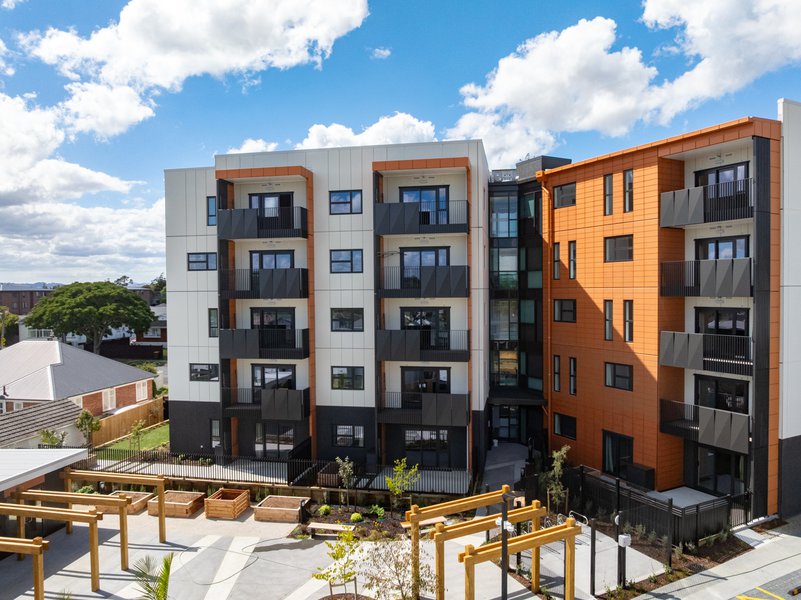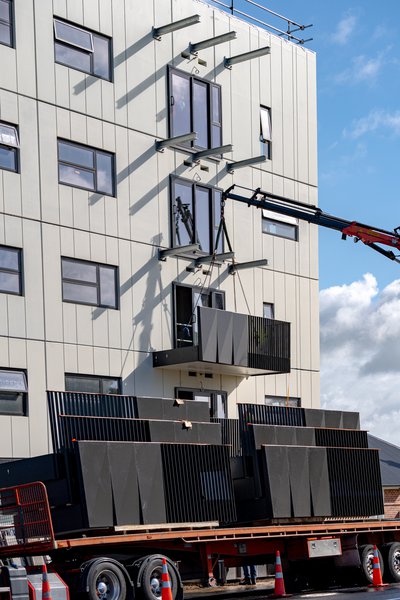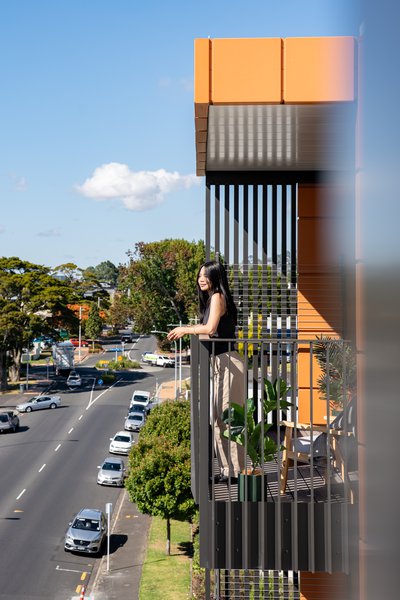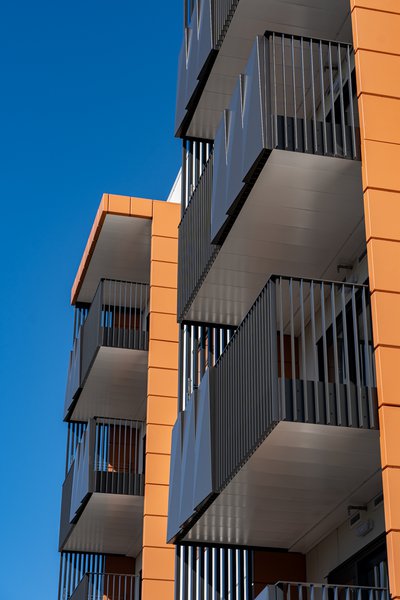“A lot of building projects across New Zealand were put on pause over the last couple of years, but with a gradually improving economic outlook, we’re starting to see those come back online,” says William Stewart, Managing Director at Belcanto. “The buy-in for our lightweight, modular, factory-built Grappler Balcony system has remained really high, and architects and developers are reaching out to us now as opportunities become available to spin their projects back up.”
When Teulo last caught up with William in 2023, Belcanto was seeing some of its early projects reach completion, and the industry was starting to take notice of how Belcanto could improve the quality and efficiency of their builds. “At that time we were working on a number of projects in the social housing space, including Kāinga Ora’s Victoria and Seddon Street Apartments in Pukekohe,” William says. “This was a great example of a project done really well. Our balconies helped bring life to an otherwise very straightforward façade, and we installed all 20 of them in just two days. We were able to offer a more cost-effective option than a traditional concrete balcony system, and we supported the architect with a one-stop-shop solution that enabled them to coordinate a big component of the project through just one supplier. The end result was a quick and seamless build with a significantly lower cost per square metre than many of Kāinga Ora’s previous projects.”
Since then, New Zealand’s social housing projects have been wound back quite significantly, William says, a shift which has inspired Belcanto to dive deeper into other existing market segments while also pursuing bigger projects further afield. “Our work with balustrades and façade treatments has remained really consistent, with our balustrade segment steadily growing through projects including the new Ikea store in Auckland and the new Fisher & Paykel centre. That’s our bread and butter, which fills the peaks and troughs of the balcony projects. We also maintain a strong presence in the residential care home market; after a recent lull in those projects going to construction, we’re definitely seeing the tap turning back on now.”
Belcanto has matured a lot since its launch in 2019, cementing their ability to confidently deliver large-scale projects across a range of typologies. William is optimistic about the New Zealand market picking back up, but that hasn’t stopped his team from setting their sights firmly on expansion into Australia. “We’re spending some time and effort there talking to major developers and builders, particularly in New South Wales. We’ve priced about a dozen projects so far, and we’re hoping to do some work with Homes NSW, the local social housing department. We’ve also identified a big opportunity with Cross-Laminated Timber (CLT) buildings, some of which have had historic moisture challenges using CLT balcony construction. A lot of major Australian engineering firms are now looking for alternatives, which Belcanto can provide. The scale that we’re looking at over there is next level. Where a big project here might include 100 balconies, in Sydney it could easily be 10x that. We’re aiming to lock in our first Australian project before Christmas and install it some time next year.
Belcanto has also invested heavily in Autodesk software this year and is currently involved in a new incubator programme. “We agree that the future of construction lies in digital design tools and software. Autodesk can see that we’re quite a good case study for how to implement these tools because we control the whole product lifecycle: early design, engineering, manufacturing, installation, and even post-completion. We’re currently working with them to test and develop software for future release.”
Navigating the 2025 economic climate is largely about getting creative, William says, both for suppliers and for architects and developers. “We’ve expanded our portfolio into South Island cities like Christchurch and Queenstown, rather than focusing just on the main North Island centres. New high-rise apartment buildings are less prevalent in New Zealand than they were a few years ago, so we’re looking at how we can support smaller projects, including the Auckland Council Tamaki Regeneration Company, where we’ve been able to demonstrate the cost viability for a project with just eight balconies. We’ve proven that our pricing still stands up even at small volumes, which opens up a lot of new opportunities for us. We’ve also been persistent about historical projects that are now finally being funded, including the Hospital Road Apartments, a social housing project with Te Whānau o Waipareira in Ōtāhuhu. After a long time on hold, this is now underway, with the foundations complete and the first floor going in now. We’ll be on-site there next year to install 84 balconies; that size of build in New Zealand right now is very rare.”
The key to getting projects moving again and supporting new projects currently in development is to increase their build efficiency, William says. “Material costs have stabilised a bit after a turbulent couple of years, but labour costs are still going up. Ultimately, the only thing you can fully control on your building site is the number of people who need to be there. Keeping costs down requires finding ways to have fewer people on-site, and this requires different ways of working. Belcanto is encouraging the industry to consider how much more can be done in a factory environment and how much quicker their builds can happen as a result.
“For industry professionals who are struggling to get project costs to stack up, we’d love to connect. There’s real potential for Belcanto to help you get it over the line with savings in both time and cost. If you have a traditional concrete build that’s been put on hold, get in touch. We can update your programme with our Grappler Balconies and potentially save you up to three months of time on site.”
To learn more and connect with William, send him a message at william@belcanto.co.nz, follow Belcanto on LinkedIn, or come say hello at the upcoming Teulo Talks live event in Auckland.






